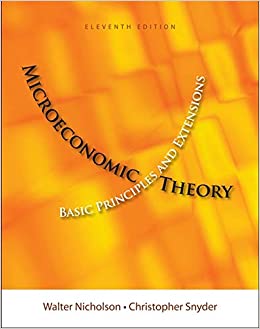
Microeconomic Theory 11th Edition by Walter Nicholson,Christopher Snyder
Edition 11ISBN: 978-1111525538
Microeconomic Theory 11th Edition by Walter Nicholson,Christopher Snyder
Edition 11ISBN: 978-1111525538 Exercise 2
As we saw in this chapter, the elements of labor supply theory can also be derived from an expenditure-minimization approach. Suppose a person's utility function for consumption and leisure takes the Cobb-Douglas form
 . Then the expenditure-minimization problem is
. Then the expenditure-minimization problem is

a. Use this approach to derive the expenditure function for this problem.
b. Use the envelope theorem to derive the compensated demand functions for consumption and leisure.
c. Derive the compensated labor supply function. Show that
 .
.
d. Compare the compensated labor supply function from part (c) to the uncompensated labor supply function in Example 16.2 (with n =0). Use the Slutsky equation to show why income and substitution effects of a change in the real wage are precisely offsetting in the uncompensated Cobb-Douglas labor supply function
 . Then the expenditure-minimization problem is
. Then the expenditure-minimization problem is
a. Use this approach to derive the expenditure function for this problem.
b. Use the envelope theorem to derive the compensated demand functions for consumption and leisure.
c. Derive the compensated labor supply function. Show that
 .
.d. Compare the compensated labor supply function from part (c) to the uncompensated labor supply function in Example 16.2 (with n =0). Use the Slutsky equation to show why income and substitution effects of a change in the real wage are precisely offsetting in the uncompensated Cobb-Douglas labor supply function
Explanation
In order to find the optimal consumption...
Microeconomic Theory 11th Edition by Walter Nicholson,Christopher Snyder
Why don’t you like this exercise?
Other Minimum 8 character and maximum 255 character
Character 255


